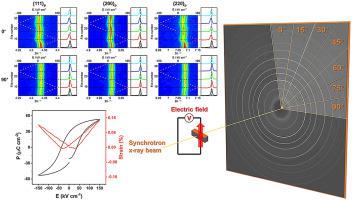Materials Today Physics ( IF 11.5 ) Pub Date : 2021-05-03 , DOI: 10.1016/j.mtphys.2021.100426 Zhilun Lu , Ge Wang , Linhao Li , Yuhe Huang , Antonio Feteira , Weichao Bao , Annette K. Kleppe , Fangfang Xu , Dawei Wang , Ian M. Reaney

|
The origin of the large electrostrain in BiFeO3-BaTiO3 (BF-BT) ceramics is controversial and has been attributed to either a field-induced transition to a long-range ferroelectric (FE) state or to multi-symmetry, polar nanoregions within a pseudocubic matrix whose vectors approximately align with the direction of the applied field. The (1-x)BiFeO3-xSrTiO3 (BF-xST) solid solution is structurally and microstructurally similar to BF-BT and provides a further case study to assess the origin of electrostrain. In BF-xST, electrostrain is optimized at x = 0.4 (0.15%) which zero field, room temperature full-pattern X-ray diffraction (XRD) Rietveld refinement and scanning/transmission electron microscopy suggest is composed of 15% rhombohedral (R) cores, surrounded by 85% pseudocubic (PC) shells. In-situ poling synchrotron XRD reveals that all peaks remain singlet and exhibit no change in full width half maximum up to 100 kV cm−1, confirming the absence of long-range FE order and the retention of short-range polar order, despite the large applied field. Strain anisotropy (calculated from individual peaks) of ε220 > ε111 > ε200 and the associated strain orientation distribution however, indicate the existence of local orthorhombic (O), R and tetragonal (T) symmetries. The data therefore imply the existence under poling of multi-symmetry polar nanoregions in BF-0.4ST rather than a long FE phase, supporting the model described by Wang and co-workers (2019) for BF-BT compositions.
中文翻译:

在原位极化无铅的的BiFeO X射线衍射研究3 -SrTiO 3陶瓷
BiFeO 3 -BaTiO 3(BF-BT)陶瓷中的大电应变的起源是有争议的,并且归因于电场诱导的到长距离铁电(FE)态的跃迁,或者归因于其中的多对称极性纳米区域一个伪三次矩阵,其向量与施加场的方向大致对齐。的(1- X)的BiFeO 3 - X的SrTiO 3(BF- X ST)固溶体在结构上和微观结构类似于BF-BT,并提供了进一步的案例研究,以评估电致伸缩的起源。在BF- x ST中,将电应变优化为x = 0.4(0.15%),其中零场,室温全模式X射线衍射(XRD)Rietveld细化和扫描/透射电子显微镜表明由15%的菱面体(R)核组成,被85%的伪立方(PC)包围贝壳。原位极化同步加速器XRD显示,即使在100 kV cm -1以下,所有峰仍保持单峰态,半峰全宽没有变化,这证实了尽管存在广阔的应用领域。的应变ε各向异性(从各个峰计算)220 >ε 111 >ε 200然而,相关的应变取向分布表明存在局部正交的(O),R和四边形(T)对称性。因此,数据暗示在BF-0.4ST中存在多个对称极性纳米区域,而不是一个长的FE相,这支持了Wang和他的同事(2019)描述的BF- BT组成的模型。



























 京公网安备 11010802027423号
京公网安备 11010802027423号